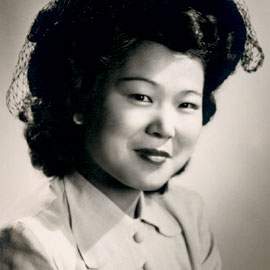 |


|
Spring 2004 | Volume 26, Number 6 | Features |
||||
| Dear Toshiko Letters From 1942 Unearth a Tantalizing Mystery for 2004 History Students THERE ARE CERTAIN DISCOVERIES that quite literally cause a history
buff to tremble. This was one of them.
In February, Seattle Pacific junior and history major Katie Stalley stumbled upon two yellowed letters found in Seattle Pacific University’s archives by student employee Adrienne Thun. More than just everyday correspondence, the aging pages brought to light a mystery — one Stalley says she was determined to solve. “It was like stepping back in time,” she says of the letters, one from Seattle Pacific College student Toshiko Senda ’42 and the other from former SPC President C. Hoyt Watson. Senda’s words were cheerful but urgent, and Stalley read them with increasing amazement. “Dear President Watson, when I left SPC you asked about my coming back for Commencement exercises,” wrote Senda. “The Headquarters’ Office has told me that if I have someone be my custodian while I am gone and also have someone come and get me I will have an easier time getting out … Another thing, too, will you please arrange about my cap and gown?” Under normal circumstances, Senda’s plea might not sound so extraordinary. But it was five months after the attack on Pearl Harbor, and she was Japanese-American. “Leaving SPC” meant being incarcerated at a camp in Puyallup, Washington, for Japanese-American citizens. “President Watson recognized the urgency of her message,” says Stalley. Written two days later, his letter on behalf of Senda to the camp manager read, “By vote of our faculty, she is being graduated … We are very anxious for Miss Senda to be present to receive her diploma and degree.” He goes on to say that he has arranged for another student to pick her up from camp. “We had these two beautiful letters from 1942, but we didn’t have all the evidence to know what actually happened,” relates Stalley. So she looped in her roommate, SPU junior Kirstin Shomura, and the other eight members of the history club Histeria!, and in her spare time led a massive research project to solve the mystery. The students were able to locate Senda’s husband, Kay Takeoka, a dentist living in Alameda, California. But the discovery was bittersweet; they learned that Senda died in 2001 after a long battle with Alzheimer’s disease. While their friends spent Spring Break relaxing, Stalley and Shomura flew to California, where they interviewed Takeoka and learned more about Senda’s life: her graduate education at Columbia University, her years of teaching children at a small Christian school in California and her love of singing in the church choir. Takeoka even brought out Senda’s 1942 SPC yearbook. “Just by reading her yearbook, you can see how well-liked she was,” says Shomura, noting that Senda was a member of several campus clubs, as well as student government. From there, Stalley contacted Senda’s younger sister, Miyoko McCoy, who said she remembered her sister leaving camp in time for Commencement. “Of course, it was very rewarding to hear that,” says Stalley. “But in my mind, I’m still a little skeptical, because I don’t know the whole story. Toshiko isn’t here to tell me, and Will Hunter ’41, the student who was supposed to pick her up from camp, has passed away.” So in some ways, the story remains a mystery — one Stalley hopes won’t be forgotten. She wants to help create an on-campus memorial for Senda and other Japanese-American students sent to internment camps during World War II. “When we began digging, we discovered so many connections to Toshiko’s life, and I know there are more out there,” says Stalley, who urges Response readers with ties to Senda’s story, or stories of their own related to the Japanese-American internment during World War II, to contact her. “It’s such an important piece of history, and it reminds us that this is a campus that stands for justice, peace and love.” Even though delayed by more than 60 years, Senda relays that same message in her 1942 letter to her Seattle Pacific friends, then and now. “May the Lord’s richest blessing and guidance be upon you and yours for the remainder of the quarter and always,” she writes. “Most sincerely yours, Toshiko Senda.” — BY SARAH JIO Back to Home |
|
